TLIG2007 Written Assessment: Working in Socially Diverse Environments
VerifiedAdded on 2023/06/18
|32
|7770
|236
Homework Assignment
AI Summary
This document presents a solved assignment for TLIG2007, focusing on working effectively in a socially diverse environment. It includes true/false questions on racial discrimination acts and cultural diversity in Australia, followed by case studies addressing equality, diversity, and discrimination in various workplace scenarios, specifically within a training environment. The case studies cover situations involving religious accommodation, communication challenges related to cultural norms, and addressing potential racism and discrimination. Furthermore, the assignment explores the importance of cultural understanding in verbal and non-verbal communication and provides actionable steps for developing a deeper understanding of cultural differences, such as self-awareness, research, intercultural dialogue, travel, and acceptance. The solutions provided offer insights into handling these complex situations professionally and ethically.
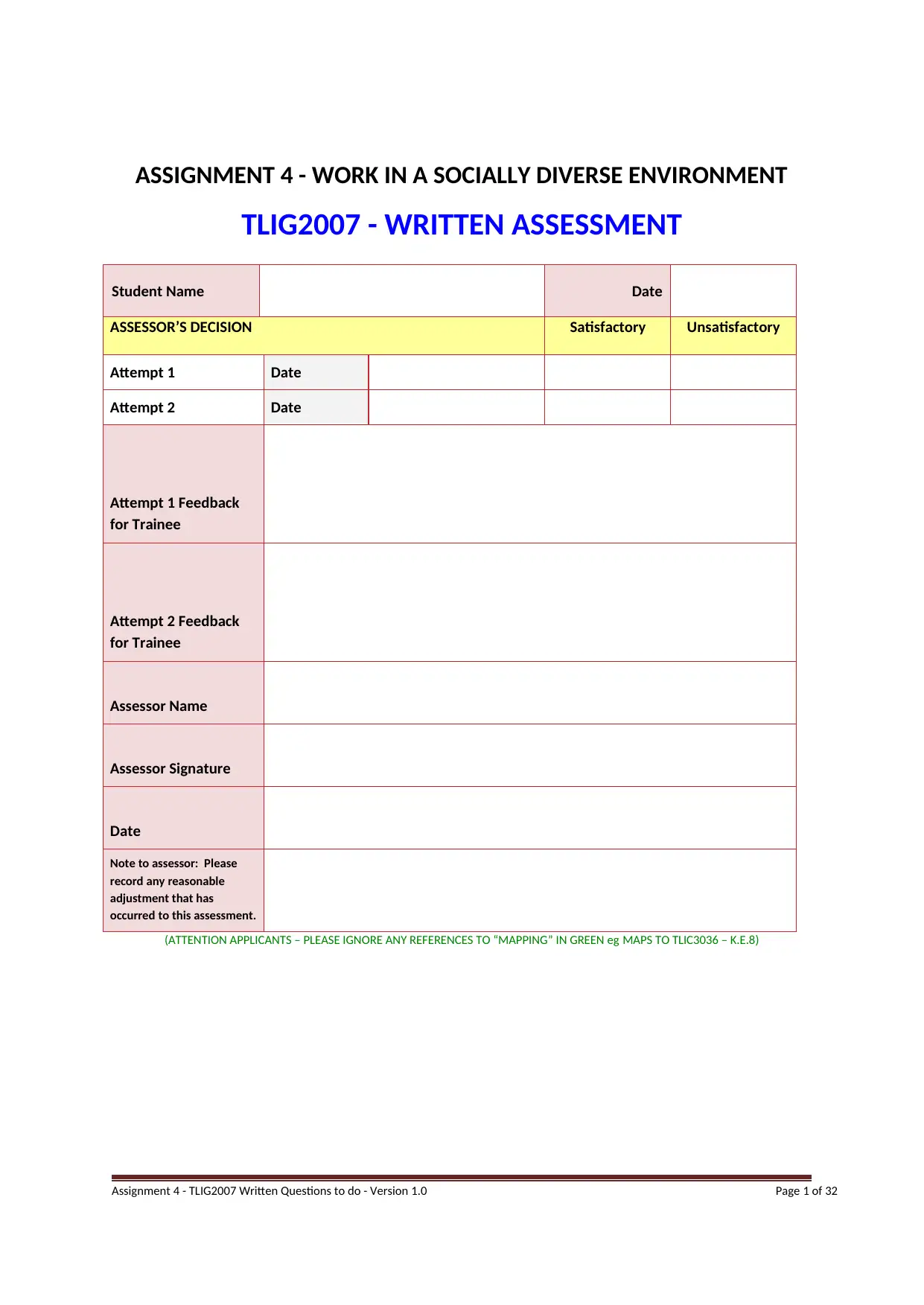
ASSIGNMENT 4 - WORK IN A SOCIALLY DIVERSE ENVIRONMENT
TLIG2007 - WRITTEN ASSESSMENT
Student Name Date
ASSESSOR’S DECISION Satisfactory Unsatisfactory
Attempt 1 Date
Attempt 2 Date
Attempt 1 Feedback
for Trainee
Attempt 2 Feedback
for Trainee
Assessor Name
Assessor Signature
Date
Note to assessor: Please
record any reasonable
adjustment that has
occurred to this assessment.
(ATTENTION APPLICANTS – PLEASE IGNORE ANY REFERENCES TO “MAPPING” IN GREEN eg MAPS TO TLIC3036 – K.E.8)
Assignment 4 - TLIG2007 Written Questions to do - Version 1.0 Page 1 of 32
TLIG2007 - WRITTEN ASSESSMENT
Student Name Date
ASSESSOR’S DECISION Satisfactory Unsatisfactory
Attempt 1 Date
Attempt 2 Date
Attempt 1 Feedback
for Trainee
Attempt 2 Feedback
for Trainee
Assessor Name
Assessor Signature
Date
Note to assessor: Please
record any reasonable
adjustment that has
occurred to this assessment.
(ATTENTION APPLICANTS – PLEASE IGNORE ANY REFERENCES TO “MAPPING” IN GREEN eg MAPS TO TLIC3036 – K.E.8)
Assignment 4 - TLIG2007 Written Questions to do - Version 1.0 Page 1 of 32
Paraphrase This Document
Need a fresh take? Get an instant paraphrase of this document with our AI Paraphraser
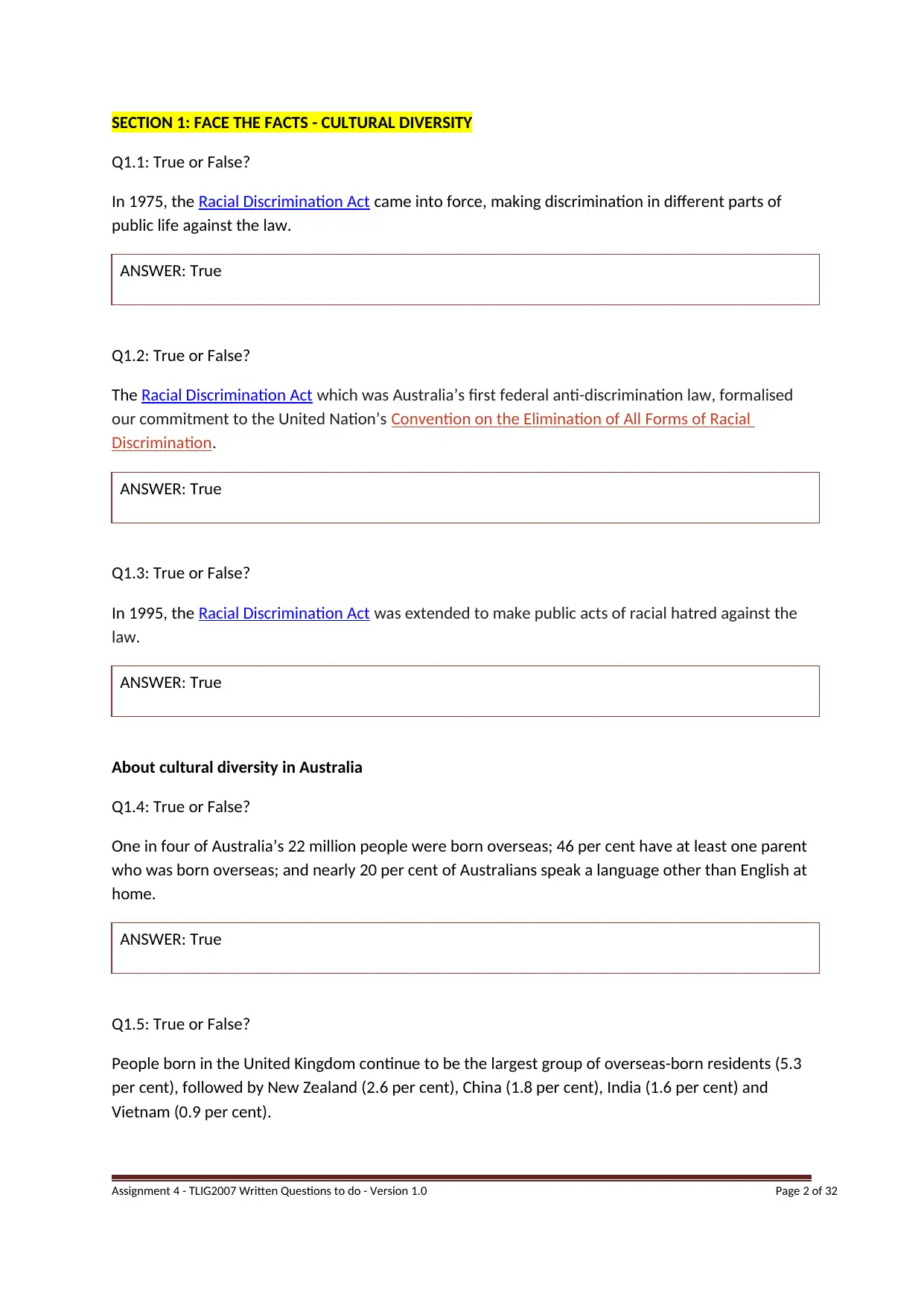
SECTION 1: FACE THE FACTS - CULTURAL DIVERSITY
Q1.1: True or False?
In 1975, the Racial Discrimination Act came into force, making discrimination in different parts of
public life against the law.
ANSWER: True
Q1.2: True or False?
The Racial Discrimination Act which was Australia’s first federal anti-discrimination law, formalised
our commitment to the United Nation’s Convention on the Elimination of All Forms of Racial
Discrimination.
ANSWER: True
Q1.3: True or False?
In 1995, the Racial Discrimination Act was extended to make public acts of racial hatred against the
law.
ANSWER: True
About cultural diversity in Australia
Q1.4: True or False?
One in four of Australia’s 22 million people were born overseas; 46 per cent have at least one parent
who was born overseas; and nearly 20 per cent of Australians speak a language other than English at
home.
ANSWER: True
Q1.5: True or False?
People born in the United Kingdom continue to be the largest group of overseas-born residents (5.3
per cent), followed by New Zealand (2.6 per cent), China (1.8 per cent), India (1.6 per cent) and
Vietnam (0.9 per cent).
Assignment 4 - TLIG2007 Written Questions to do - Version 1.0 Page 2 of 32
Q1.1: True or False?
In 1975, the Racial Discrimination Act came into force, making discrimination in different parts of
public life against the law.
ANSWER: True
Q1.2: True or False?
The Racial Discrimination Act which was Australia’s first federal anti-discrimination law, formalised
our commitment to the United Nation’s Convention on the Elimination of All Forms of Racial
Discrimination.
ANSWER: True
Q1.3: True or False?
In 1995, the Racial Discrimination Act was extended to make public acts of racial hatred against the
law.
ANSWER: True
About cultural diversity in Australia
Q1.4: True or False?
One in four of Australia’s 22 million people were born overseas; 46 per cent have at least one parent
who was born overseas; and nearly 20 per cent of Australians speak a language other than English at
home.
ANSWER: True
Q1.5: True or False?
People born in the United Kingdom continue to be the largest group of overseas-born residents (5.3
per cent), followed by New Zealand (2.6 per cent), China (1.8 per cent), India (1.6 per cent) and
Vietnam (0.9 per cent).
Assignment 4 - TLIG2007 Written Questions to do - Version 1.0 Page 2 of 32
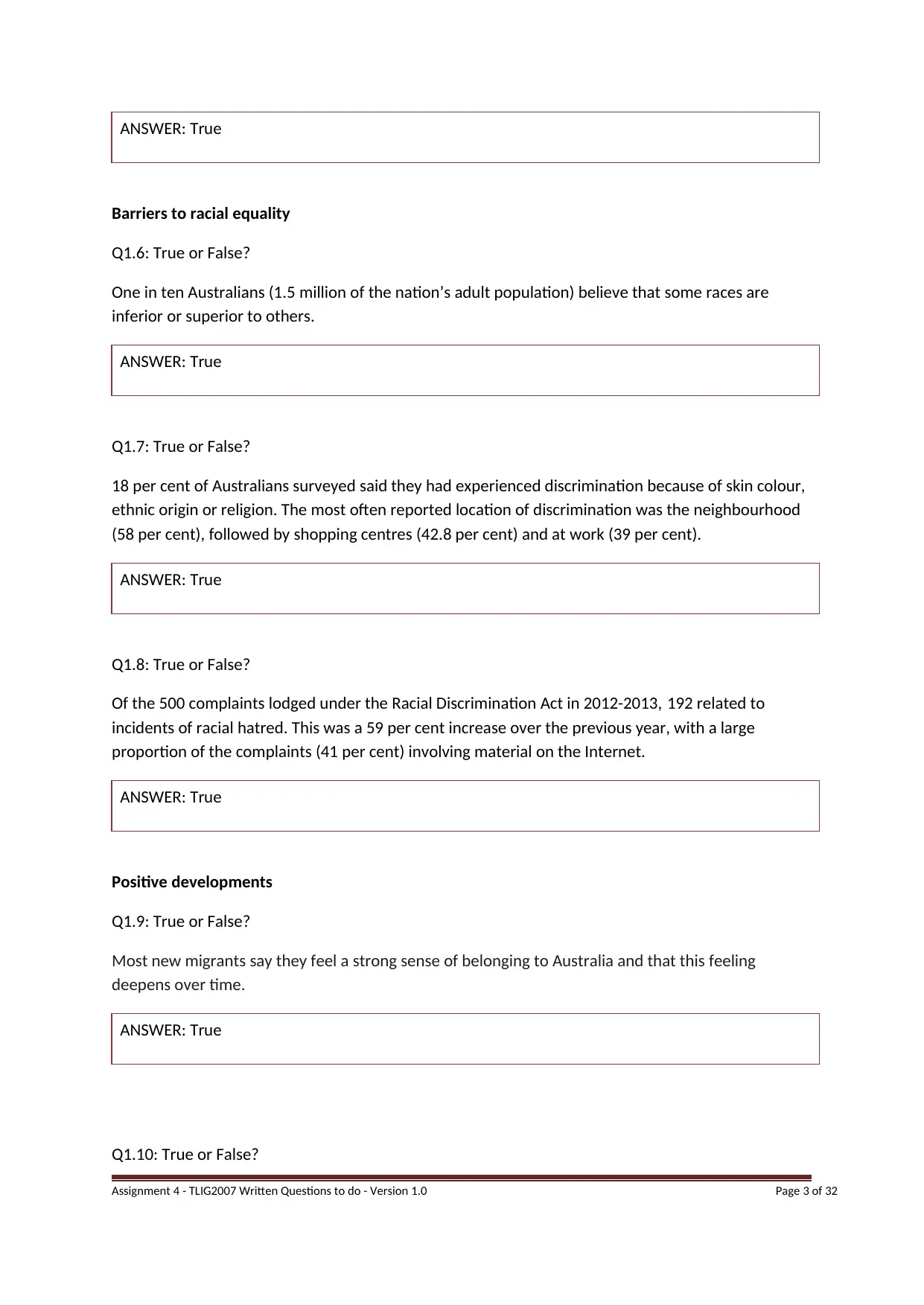
ANSWER: True
Barriers to racial equality
Q1.6: True or False?
One in ten Australians (1.5 million of the nation’s adult population) believe that some races are
inferior or superior to others.
ANSWER: True
Q1.7: True or False?
18 per cent of Australians surveyed said they had experienced discrimination because of skin colour,
ethnic origin or religion. The most often reported location of discrimination was the neighbourhood
(58 per cent), followed by shopping centres (42.8 per cent) and at work (39 per cent).
ANSWER: True
Q1.8: True or False?
Of the 500 complaints lodged under the Racial Discrimination Act in 2012-2013, 192 related to
incidents of racial hatred. This was a 59 per cent increase over the previous year, with a large
proportion of the complaints (41 per cent) involving material on the Internet.
ANSWER: True
Positive developments
Q1.9: True or False?
Most new migrants say they feel a strong sense of belonging to Australia and that this feeling
deepens over time.
ANSWER: True
Q1.10: True or False?
Assignment 4 - TLIG2007 Written Questions to do - Version 1.0 Page 3 of 32
Barriers to racial equality
Q1.6: True or False?
One in ten Australians (1.5 million of the nation’s adult population) believe that some races are
inferior or superior to others.
ANSWER: True
Q1.7: True or False?
18 per cent of Australians surveyed said they had experienced discrimination because of skin colour,
ethnic origin or religion. The most often reported location of discrimination was the neighbourhood
(58 per cent), followed by shopping centres (42.8 per cent) and at work (39 per cent).
ANSWER: True
Q1.8: True or False?
Of the 500 complaints lodged under the Racial Discrimination Act in 2012-2013, 192 related to
incidents of racial hatred. This was a 59 per cent increase over the previous year, with a large
proportion of the complaints (41 per cent) involving material on the Internet.
ANSWER: True
Positive developments
Q1.9: True or False?
Most new migrants say they feel a strong sense of belonging to Australia and that this feeling
deepens over time.
ANSWER: True
Q1.10: True or False?
Assignment 4 - TLIG2007 Written Questions to do - Version 1.0 Page 3 of 32
⊘ This is a preview!⊘
Do you want full access?
Subscribe today to unlock all pages.

Trusted by 1+ million students worldwide
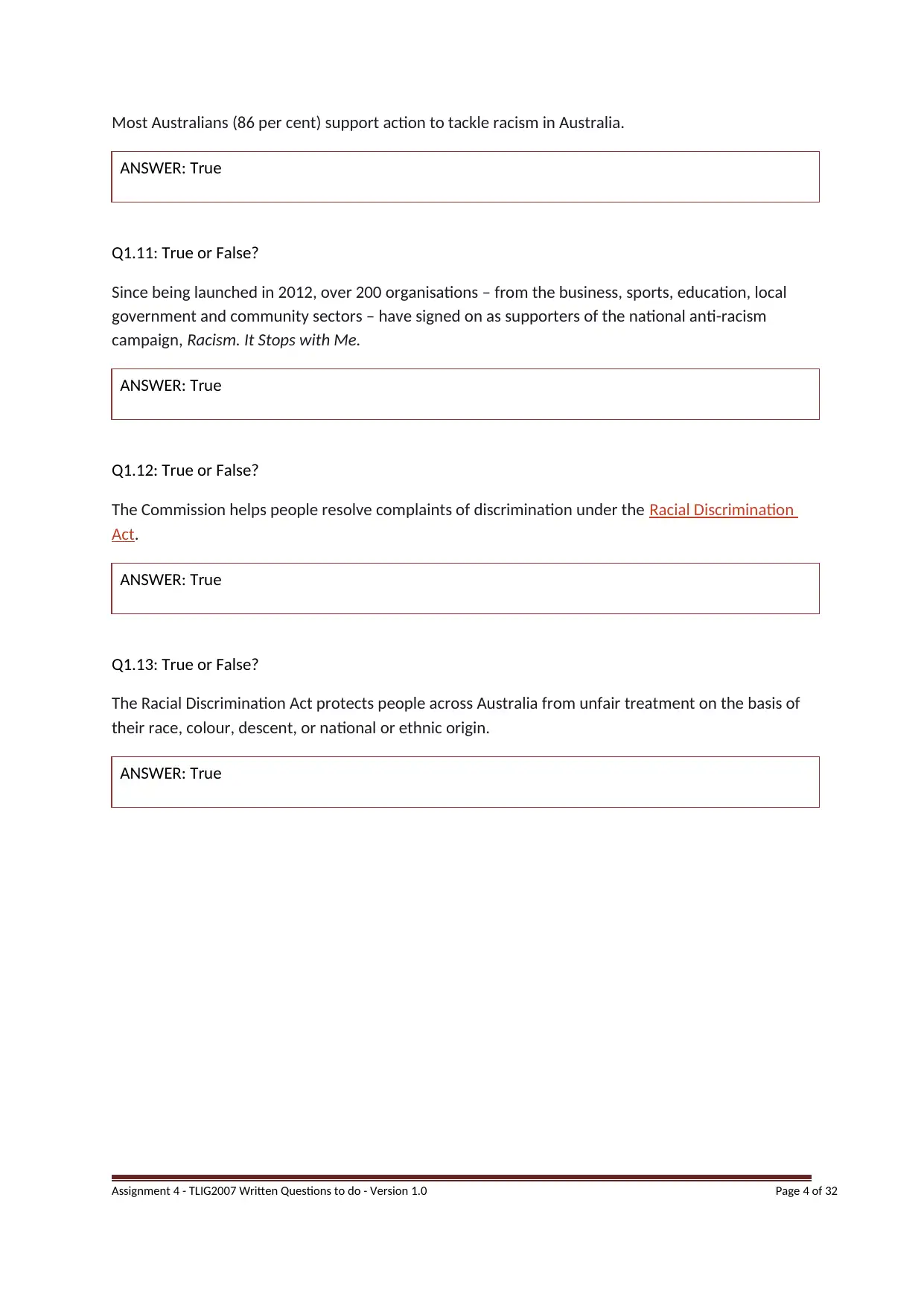
Most Australians (86 per cent) support action to tackle racism in Australia.
ANSWER: True
Q1.11: True or False?
Since being launched in 2012, over 200 organisations – from the business, sports, education, local
government and community sectors – have signed on as supporters of the national anti-racism
campaign, Racism. It Stops with Me.
ANSWER: True
Q1.12: True or False?
The Commission helps people resolve complaints of discrimination under the Racial Discrimination
Act.
ANSWER: True
Q1.13: True or False?
The Racial Discrimination Act protects people across Australia from unfair treatment on the basis of
their race, colour, descent, or national or ethnic origin.
ANSWER: True
Assignment 4 - TLIG2007 Written Questions to do - Version 1.0 Page 4 of 32
ANSWER: True
Q1.11: True or False?
Since being launched in 2012, over 200 organisations – from the business, sports, education, local
government and community sectors – have signed on as supporters of the national anti-racism
campaign, Racism. It Stops with Me.
ANSWER: True
Q1.12: True or False?
The Commission helps people resolve complaints of discrimination under the Racial Discrimination
Act.
ANSWER: True
Q1.13: True or False?
The Racial Discrimination Act protects people across Australia from unfair treatment on the basis of
their race, colour, descent, or national or ethnic origin.
ANSWER: True
Assignment 4 - TLIG2007 Written Questions to do - Version 1.0 Page 4 of 32
Paraphrase This Document
Need a fresh take? Get an instant paraphrase of this document with our AI Paraphraser
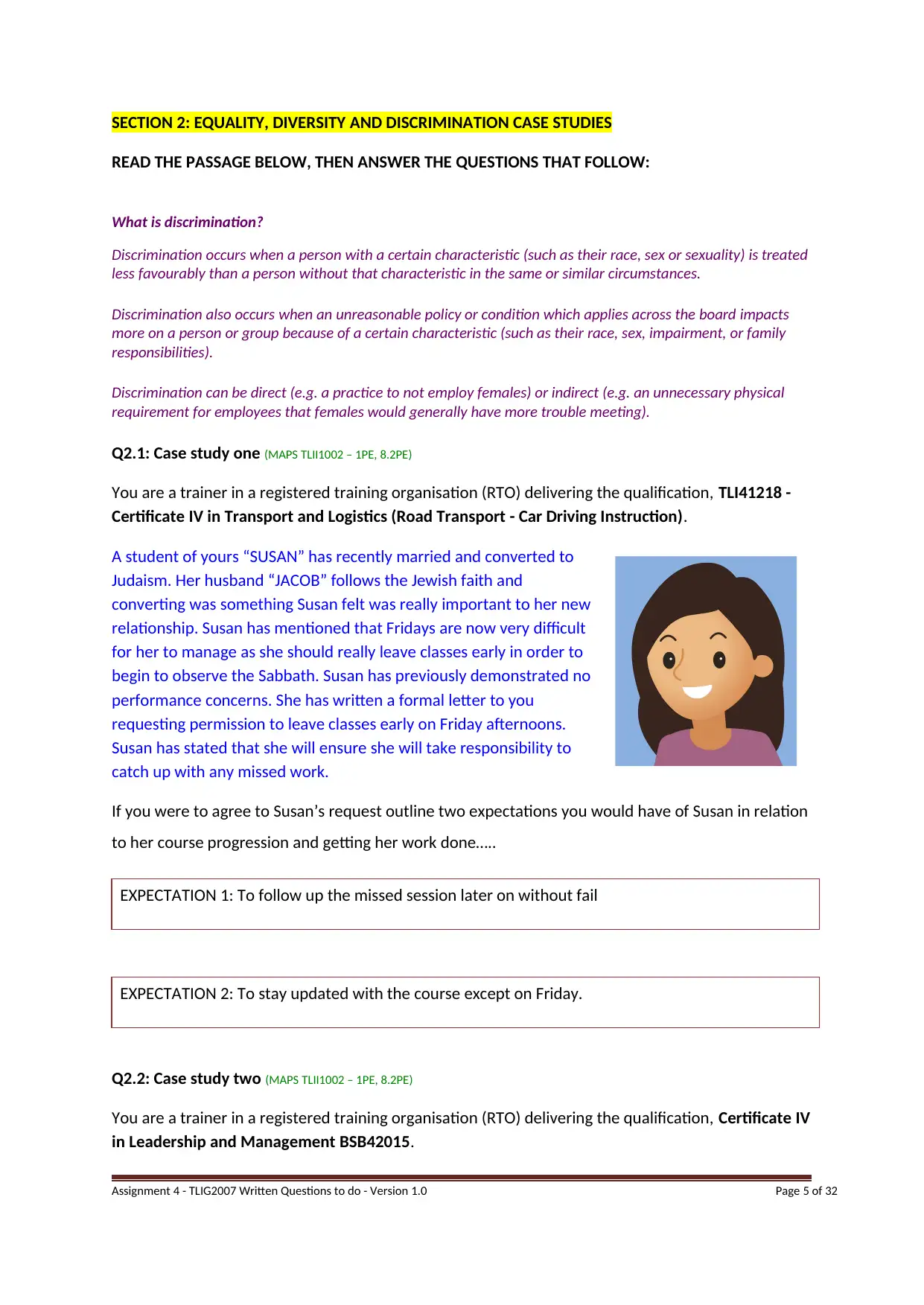
SECTION 2: EQUALITY, DIVERSITY AND DISCRIMINATION CASE STUDIES
READ THE PASSAGE BELOW, THEN ANSWER THE QUESTIONS THAT FOLLOW:
What is discrimination?
Discrimination occurs when a person with a certain characteristic (such as their race, sex or sexuality) is treated
less favourably than a person without that characteristic in the same or similar circumstances.
Discrimination also occurs when an unreasonable policy or condition which applies across the board impacts
more on a person or group because of a certain characteristic (such as their race, sex, impairment, or family
responsibilities).
Discrimination can be direct (e.g. a practice to not employ females) or indirect (e.g. an unnecessary physical
requirement for employees that females would generally have more trouble meeting).
Q2.1: Case study one (MAPS TLII1002 – 1PE, 8.2PE)
You are a trainer in a registered training organisation (RTO) delivering the qualification, TLI41218 -
Certificate IV in Transport and Logistics (Road Transport - Car Driving Instruction).
A student of yours “SUSAN” has recently married and converted to
Judaism. Her husband “JACOB” follows the Jewish faith and
converting was something Susan felt was really important to her new
relationship. Susan has mentioned that Fridays are now very difficult
for her to manage as she should really leave classes early in order to
begin to observe the Sabbath. Susan has previously demonstrated no
performance concerns. She has written a formal letter to you
requesting permission to leave classes early on Friday afternoons.
Susan has stated that she will ensure she will take responsibility to
catch up with any missed work.
If you were to agree to Susan’s request outline two expectations you would have of Susan in relation
to her course progression and getting her work done…..
EXPECTATION 1: To follow up the missed session later on without fail
EXPECTATION 2: To stay updated with the course except on Friday.
Q2.2: Case study two (MAPS TLII1002 – 1PE, 8.2PE)
You are a trainer in a registered training organisation (RTO) delivering the qualification, Certificate IV
in Leadership and Management BSB42015.
Assignment 4 - TLIG2007 Written Questions to do - Version 1.0 Page 5 of 32
READ THE PASSAGE BELOW, THEN ANSWER THE QUESTIONS THAT FOLLOW:
What is discrimination?
Discrimination occurs when a person with a certain characteristic (such as their race, sex or sexuality) is treated
less favourably than a person without that characteristic in the same or similar circumstances.
Discrimination also occurs when an unreasonable policy or condition which applies across the board impacts
more on a person or group because of a certain characteristic (such as their race, sex, impairment, or family
responsibilities).
Discrimination can be direct (e.g. a practice to not employ females) or indirect (e.g. an unnecessary physical
requirement for employees that females would generally have more trouble meeting).
Q2.1: Case study one (MAPS TLII1002 – 1PE, 8.2PE)
You are a trainer in a registered training organisation (RTO) delivering the qualification, TLI41218 -
Certificate IV in Transport and Logistics (Road Transport - Car Driving Instruction).
A student of yours “SUSAN” has recently married and converted to
Judaism. Her husband “JACOB” follows the Jewish faith and
converting was something Susan felt was really important to her new
relationship. Susan has mentioned that Fridays are now very difficult
for her to manage as she should really leave classes early in order to
begin to observe the Sabbath. Susan has previously demonstrated no
performance concerns. She has written a formal letter to you
requesting permission to leave classes early on Friday afternoons.
Susan has stated that she will ensure she will take responsibility to
catch up with any missed work.
If you were to agree to Susan’s request outline two expectations you would have of Susan in relation
to her course progression and getting her work done…..
EXPECTATION 1: To follow up the missed session later on without fail
EXPECTATION 2: To stay updated with the course except on Friday.
Q2.2: Case study two (MAPS TLII1002 – 1PE, 8.2PE)
You are a trainer in a registered training organisation (RTO) delivering the qualification, Certificate IV
in Leadership and Management BSB42015.
Assignment 4 - TLIG2007 Written Questions to do - Version 1.0 Page 5 of 32
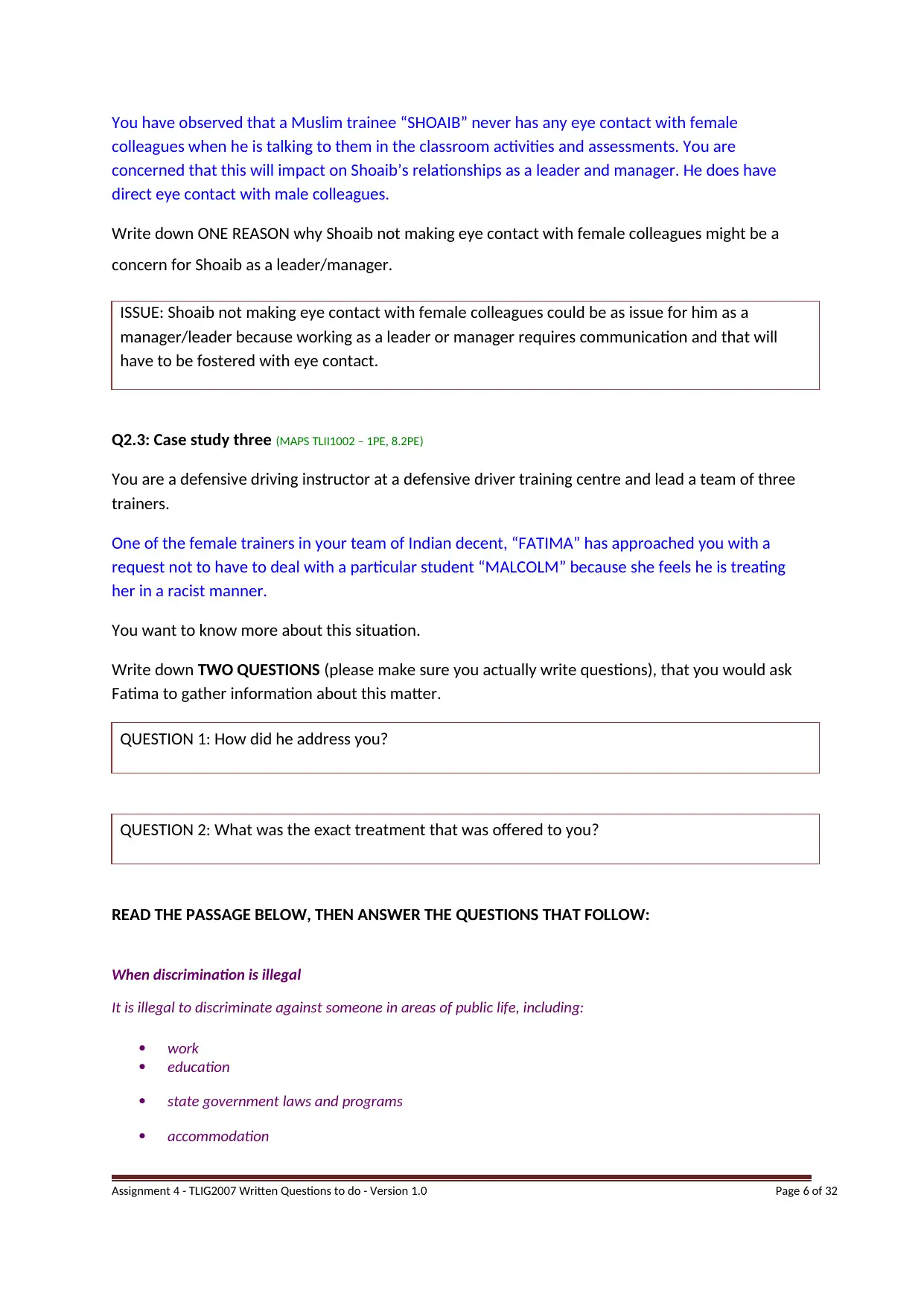
You have observed that a Muslim trainee “SHOAIB” never has any eye contact with female
colleagues when he is talking to them in the classroom activities and assessments. You are
concerned that this will impact on Shoaib’s relationships as a leader and manager. He does have
direct eye contact with male colleagues.
Write down ONE REASON why Shoaib not making eye contact with female colleagues might be a
concern for Shoaib as a leader/manager.
ISSUE: Shoaib not making eye contact with female colleagues could be as issue for him as a
manager/leader because working as a leader or manager requires communication and that will
have to be fostered with eye contact.
Q2.3: Case study three (MAPS TLII1002 – 1PE, 8.2PE)
You are a defensive driving instructor at a defensive driver training centre and lead a team of three
trainers.
One of the female trainers in your team of Indian decent, “FATIMA” has approached you with a
request not to have to deal with a particular student “MALCOLM” because she feels he is treating
her in a racist manner.
You want to know more about this situation.
Write down TWO QUESTIONS (please make sure you actually write questions), that you would ask
Fatima to gather information about this matter.
QUESTION 1: How did he address you?
QUESTION 2: What was the exact treatment that was offered to you?
READ THE PASSAGE BELOW, THEN ANSWER THE QUESTIONS THAT FOLLOW:
When discrimination is illegal
It is illegal to discriminate against someone in areas of public life, including:
work
education
state government laws and programs
accommodation
Assignment 4 - TLIG2007 Written Questions to do - Version 1.0 Page 6 of 32
colleagues when he is talking to them in the classroom activities and assessments. You are
concerned that this will impact on Shoaib’s relationships as a leader and manager. He does have
direct eye contact with male colleagues.
Write down ONE REASON why Shoaib not making eye contact with female colleagues might be a
concern for Shoaib as a leader/manager.
ISSUE: Shoaib not making eye contact with female colleagues could be as issue for him as a
manager/leader because working as a leader or manager requires communication and that will
have to be fostered with eye contact.
Q2.3: Case study three (MAPS TLII1002 – 1PE, 8.2PE)
You are a defensive driving instructor at a defensive driver training centre and lead a team of three
trainers.
One of the female trainers in your team of Indian decent, “FATIMA” has approached you with a
request not to have to deal with a particular student “MALCOLM” because she feels he is treating
her in a racist manner.
You want to know more about this situation.
Write down TWO QUESTIONS (please make sure you actually write questions), that you would ask
Fatima to gather information about this matter.
QUESTION 1: How did he address you?
QUESTION 2: What was the exact treatment that was offered to you?
READ THE PASSAGE BELOW, THEN ANSWER THE QUESTIONS THAT FOLLOW:
When discrimination is illegal
It is illegal to discriminate against someone in areas of public life, including:
work
education
state government laws and programs
accommodation
Assignment 4 - TLIG2007 Written Questions to do - Version 1.0 Page 6 of 32
⊘ This is a preview!⊘
Do you want full access?
Subscribe today to unlock all pages.

Trusted by 1+ million students worldwide
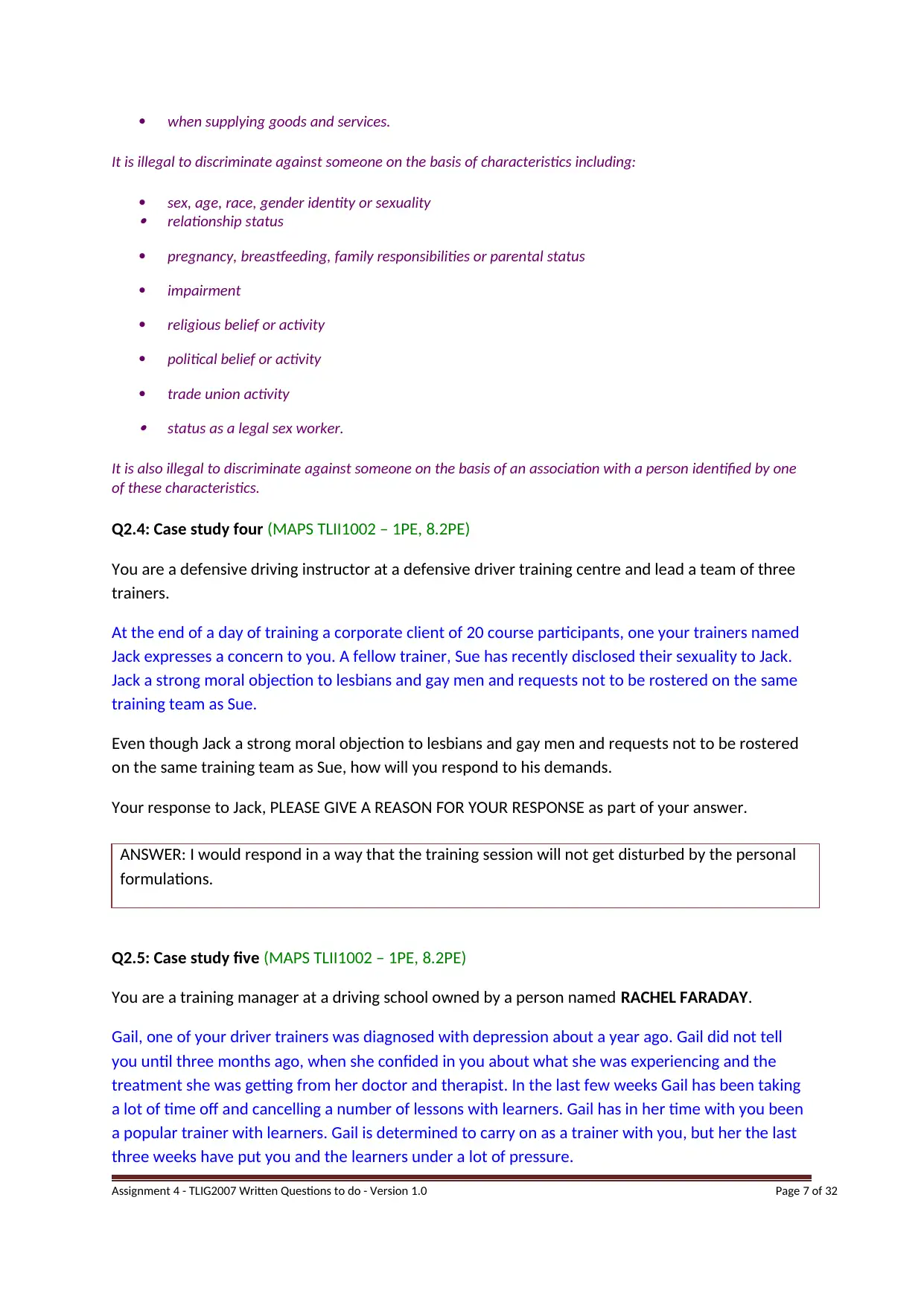
when supplying goods and services.
It is illegal to discriminate against someone on the basis of characteristics including:
sex, age, race, gender identity or sexuality
relationship status
pregnancy, breastfeeding, family responsibilities or parental status
impairment
religious belief or activity
political belief or activity
trade union activity status as a legal sex worker.
It is also illegal to discriminate against someone on the basis of an association with a person identified by one
of these characteristics.
Q2.4: Case study four (MAPS TLII1002 – 1PE, 8.2PE)
You are a defensive driving instructor at a defensive driver training centre and lead a team of three
trainers.
At the end of a day of training a corporate client of 20 course participants, one your trainers named
Jack expresses a concern to you. A fellow trainer, Sue has recently disclosed their sexuality to Jack.
Jack a strong moral objection to lesbians and gay men and requests not to be rostered on the same
training team as Sue.
Even though Jack a strong moral objection to lesbians and gay men and requests not to be rostered
on the same training team as Sue, how will you respond to his demands.
Your response to Jack, PLEASE GIVE A REASON FOR YOUR RESPONSE as part of your answer.
ANSWER: I would respond in a way that the training session will not get disturbed by the personal
formulations.
Q2.5: Case study five (MAPS TLII1002 – 1PE, 8.2PE)
You are a training manager at a driving school owned by a person named RACHEL FARADAY.
Gail, one of your driver trainers was diagnosed with depression about a year ago. Gail did not tell
you until three months ago, when she confided in you about what she was experiencing and the
treatment she was getting from her doctor and therapist. In the last few weeks Gail has been taking
a lot of time off and cancelling a number of lessons with learners. Gail has in her time with you been
a popular trainer with learners. Gail is determined to carry on as a trainer with you, but her the last
three weeks have put you and the learners under a lot of pressure.
Assignment 4 - TLIG2007 Written Questions to do - Version 1.0 Page 7 of 32
It is illegal to discriminate against someone on the basis of characteristics including:
sex, age, race, gender identity or sexuality
relationship status
pregnancy, breastfeeding, family responsibilities or parental status
impairment
religious belief or activity
political belief or activity
trade union activity status as a legal sex worker.
It is also illegal to discriminate against someone on the basis of an association with a person identified by one
of these characteristics.
Q2.4: Case study four (MAPS TLII1002 – 1PE, 8.2PE)
You are a defensive driving instructor at a defensive driver training centre and lead a team of three
trainers.
At the end of a day of training a corporate client of 20 course participants, one your trainers named
Jack expresses a concern to you. A fellow trainer, Sue has recently disclosed their sexuality to Jack.
Jack a strong moral objection to lesbians and gay men and requests not to be rostered on the same
training team as Sue.
Even though Jack a strong moral objection to lesbians and gay men and requests not to be rostered
on the same training team as Sue, how will you respond to his demands.
Your response to Jack, PLEASE GIVE A REASON FOR YOUR RESPONSE as part of your answer.
ANSWER: I would respond in a way that the training session will not get disturbed by the personal
formulations.
Q2.5: Case study five (MAPS TLII1002 – 1PE, 8.2PE)
You are a training manager at a driving school owned by a person named RACHEL FARADAY.
Gail, one of your driver trainers was diagnosed with depression about a year ago. Gail did not tell
you until three months ago, when she confided in you about what she was experiencing and the
treatment she was getting from her doctor and therapist. In the last few weeks Gail has been taking
a lot of time off and cancelling a number of lessons with learners. Gail has in her time with you been
a popular trainer with learners. Gail is determined to carry on as a trainer with you, but her the last
three weeks have put you and the learners under a lot of pressure.
Assignment 4 - TLIG2007 Written Questions to do - Version 1.0 Page 7 of 32
Paraphrase This Document
Need a fresh take? Get an instant paraphrase of this document with our AI Paraphraser
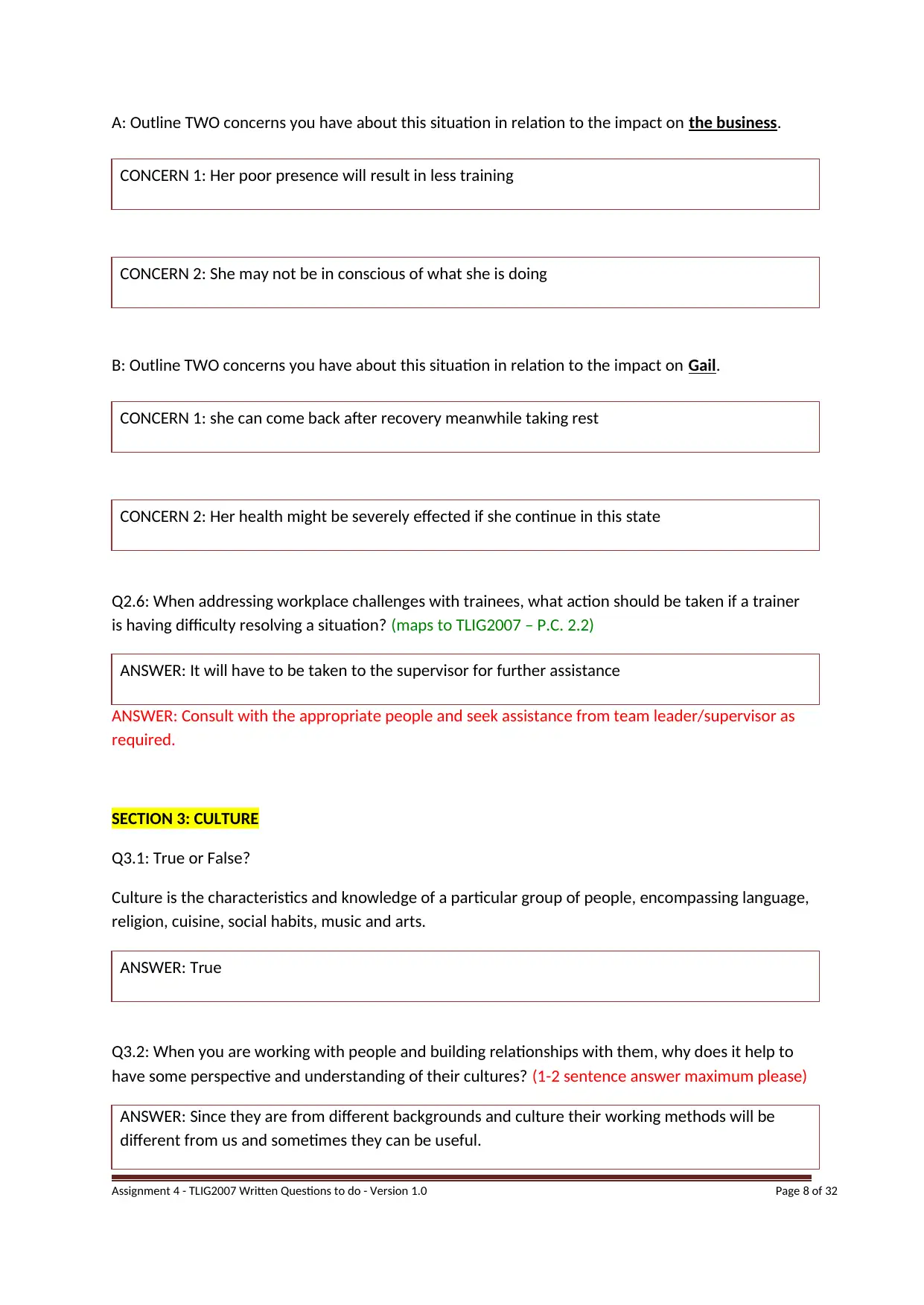
A: Outline TWO concerns you have about this situation in relation to the impact on the business.
CONCERN 1: Her poor presence will result in less training
CONCERN 2: She may not be in conscious of what she is doing
B: Outline TWO concerns you have about this situation in relation to the impact on Gail.
CONCERN 1: she can come back after recovery meanwhile taking rest
CONCERN 2: Her health might be severely effected if she continue in this state
Q2.6: When addressing workplace challenges with trainees, what action should be taken if a trainer
is having difficulty resolving a situation? (maps to TLIG2007 – P.C. 2.2)
ANSWER: It will have to be taken to the supervisor for further assistance
ANSWER: Consult with the appropriate people and seek assistance from team leader/supervisor as
required.
SECTION 3: CULTURE
Q3.1: True or False?
Culture is the characteristics and knowledge of a particular group of people, encompassing language,
religion, cuisine, social habits, music and arts.
ANSWER: True
Q3.2: When you are working with people and building relationships with them, why does it help to
have some perspective and understanding of their cultures? (1-2 sentence answer maximum please)
ANSWER: Since they are from different backgrounds and culture their working methods will be
different from us and sometimes they can be useful.
Assignment 4 - TLIG2007 Written Questions to do - Version 1.0 Page 8 of 32
CONCERN 1: Her poor presence will result in less training
CONCERN 2: She may not be in conscious of what she is doing
B: Outline TWO concerns you have about this situation in relation to the impact on Gail.
CONCERN 1: she can come back after recovery meanwhile taking rest
CONCERN 2: Her health might be severely effected if she continue in this state
Q2.6: When addressing workplace challenges with trainees, what action should be taken if a trainer
is having difficulty resolving a situation? (maps to TLIG2007 – P.C. 2.2)
ANSWER: It will have to be taken to the supervisor for further assistance
ANSWER: Consult with the appropriate people and seek assistance from team leader/supervisor as
required.
SECTION 3: CULTURE
Q3.1: True or False?
Culture is the characteristics and knowledge of a particular group of people, encompassing language,
religion, cuisine, social habits, music and arts.
ANSWER: True
Q3.2: When you are working with people and building relationships with them, why does it help to
have some perspective and understanding of their cultures? (1-2 sentence answer maximum please)
ANSWER: Since they are from different backgrounds and culture their working methods will be
different from us and sometimes they can be useful.
Assignment 4 - TLIG2007 Written Questions to do - Version 1.0 Page 8 of 32
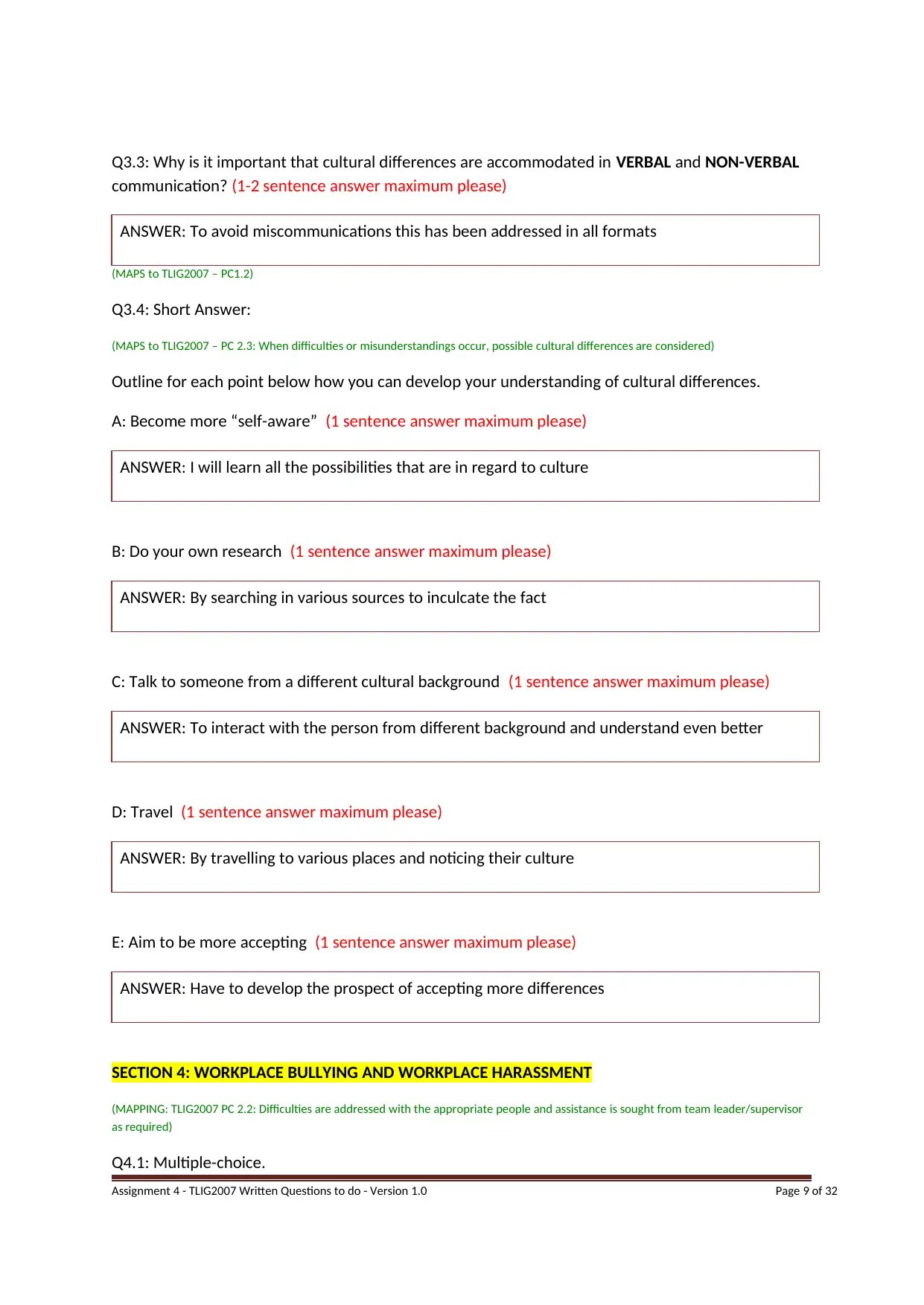
Q3.3: Why is it important that cultural differences are accommodated in VERBAL and NON-VERBAL
communication? (1-2 sentence answer maximum please)
ANSWER: To avoid miscommunications this has been addressed in all formats
(MAPS to TLIG2007 – PC1.2)
Q3.4: Short Answer:
(MAPS to TLIG2007 – PC 2.3: When difficulties or misunderstandings occur, possible cultural differences are considered)
Outline for each point below how you can develop your understanding of cultural differences.
A: Become more “self-aware” (1 sentence answer maximum please)
ANSWER: I will learn all the possibilities that are in regard to culture
B: Do your own research (1 sentence answer maximum please)
ANSWER: By searching in various sources to inculcate the fact
C: Talk to someone from a different cultural background (1 sentence answer maximum please)
ANSWER: To interact with the person from different background and understand even better
D: Travel (1 sentence answer maximum please)
ANSWER: By travelling to various places and noticing their culture
E: Aim to be more accepting (1 sentence answer maximum please)
ANSWER: Have to develop the prospect of accepting more differences
SECTION 4: WORKPLACE BULLYING AND WORKPLACE HARASSMENT
(MAPPING: TLIG2007 PC 2.2: Difficulties are addressed with the appropriate people and assistance is sought from team leader/supervisor
as required)
Q4.1: Multiple-choice.
Assignment 4 - TLIG2007 Written Questions to do - Version 1.0 Page 9 of 32
communication? (1-2 sentence answer maximum please)
ANSWER: To avoid miscommunications this has been addressed in all formats
(MAPS to TLIG2007 – PC1.2)
Q3.4: Short Answer:
(MAPS to TLIG2007 – PC 2.3: When difficulties or misunderstandings occur, possible cultural differences are considered)
Outline for each point below how you can develop your understanding of cultural differences.
A: Become more “self-aware” (1 sentence answer maximum please)
ANSWER: I will learn all the possibilities that are in regard to culture
B: Do your own research (1 sentence answer maximum please)
ANSWER: By searching in various sources to inculcate the fact
C: Talk to someone from a different cultural background (1 sentence answer maximum please)
ANSWER: To interact with the person from different background and understand even better
D: Travel (1 sentence answer maximum please)
ANSWER: By travelling to various places and noticing their culture
E: Aim to be more accepting (1 sentence answer maximum please)
ANSWER: Have to develop the prospect of accepting more differences
SECTION 4: WORKPLACE BULLYING AND WORKPLACE HARASSMENT
(MAPPING: TLIG2007 PC 2.2: Difficulties are addressed with the appropriate people and assistance is sought from team leader/supervisor
as required)
Q4.1: Multiple-choice.
Assignment 4 - TLIG2007 Written Questions to do - Version 1.0 Page 9 of 32
⊘ This is a preview!⊘
Do you want full access?
Subscribe today to unlock all pages.

Trusted by 1+ million students worldwide
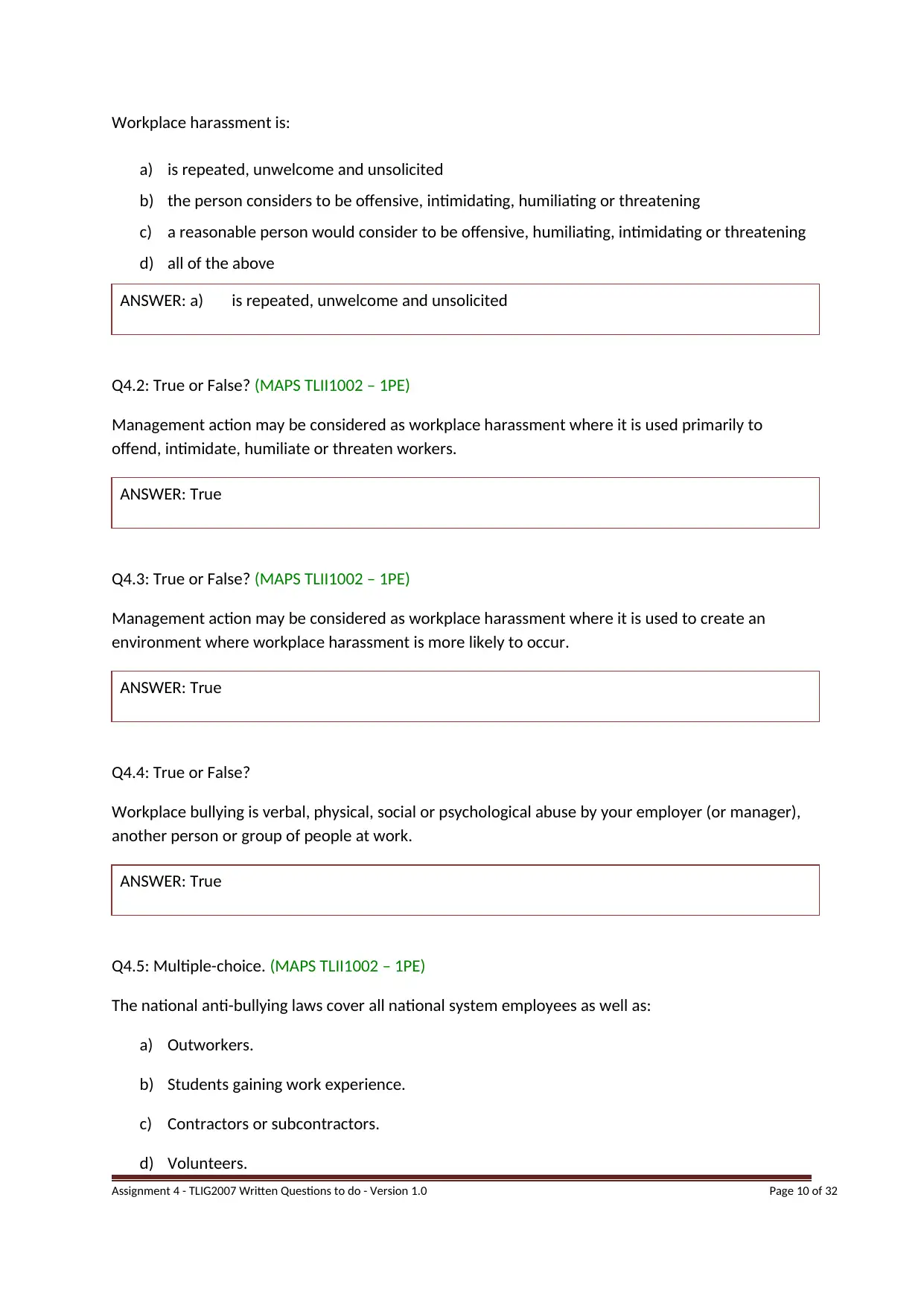
Workplace harassment is:
a) is repeated, unwelcome and unsolicited
b) the person considers to be offensive, intimidating, humiliating or threatening
c) a reasonable person would consider to be offensive, humiliating, intimidating or threatening
d) all of the above
ANSWER: a) is repeated, unwelcome and unsolicited
Q4.2: True or False? (MAPS TLII1002 – 1PE)
Management action may be considered as workplace harassment where it is used primarily to
offend, intimidate, humiliate or threaten workers.
ANSWER: True
Q4.3: True or False? (MAPS TLII1002 – 1PE)
Management action may be considered as workplace harassment where it is used to create an
environment where workplace harassment is more likely to occur.
ANSWER: True
Q4.4: True or False?
Workplace bullying is verbal, physical, social or psychological abuse by your employer (or manager),
another person or group of people at work.
ANSWER: True
Q4.5: Multiple-choice. (MAPS TLII1002 – 1PE)
The national anti-bullying laws cover all national system employees as well as:
a) Outworkers.
b) Students gaining work experience.
c) Contractors or subcontractors.
d) Volunteers.
Assignment 4 - TLIG2007 Written Questions to do - Version 1.0 Page 10 of 32
a) is repeated, unwelcome and unsolicited
b) the person considers to be offensive, intimidating, humiliating or threatening
c) a reasonable person would consider to be offensive, humiliating, intimidating or threatening
d) all of the above
ANSWER: a) is repeated, unwelcome and unsolicited
Q4.2: True or False? (MAPS TLII1002 – 1PE)
Management action may be considered as workplace harassment where it is used primarily to
offend, intimidate, humiliate or threaten workers.
ANSWER: True
Q4.3: True or False? (MAPS TLII1002 – 1PE)
Management action may be considered as workplace harassment where it is used to create an
environment where workplace harassment is more likely to occur.
ANSWER: True
Q4.4: True or False?
Workplace bullying is verbal, physical, social or psychological abuse by your employer (or manager),
another person or group of people at work.
ANSWER: True
Q4.5: Multiple-choice. (MAPS TLII1002 – 1PE)
The national anti-bullying laws cover all national system employees as well as:
a) Outworkers.
b) Students gaining work experience.
c) Contractors or subcontractors.
d) Volunteers.
Assignment 4 - TLIG2007 Written Questions to do - Version 1.0 Page 10 of 32
Paraphrase This Document
Need a fresh take? Get an instant paraphrase of this document with our AI Paraphraser
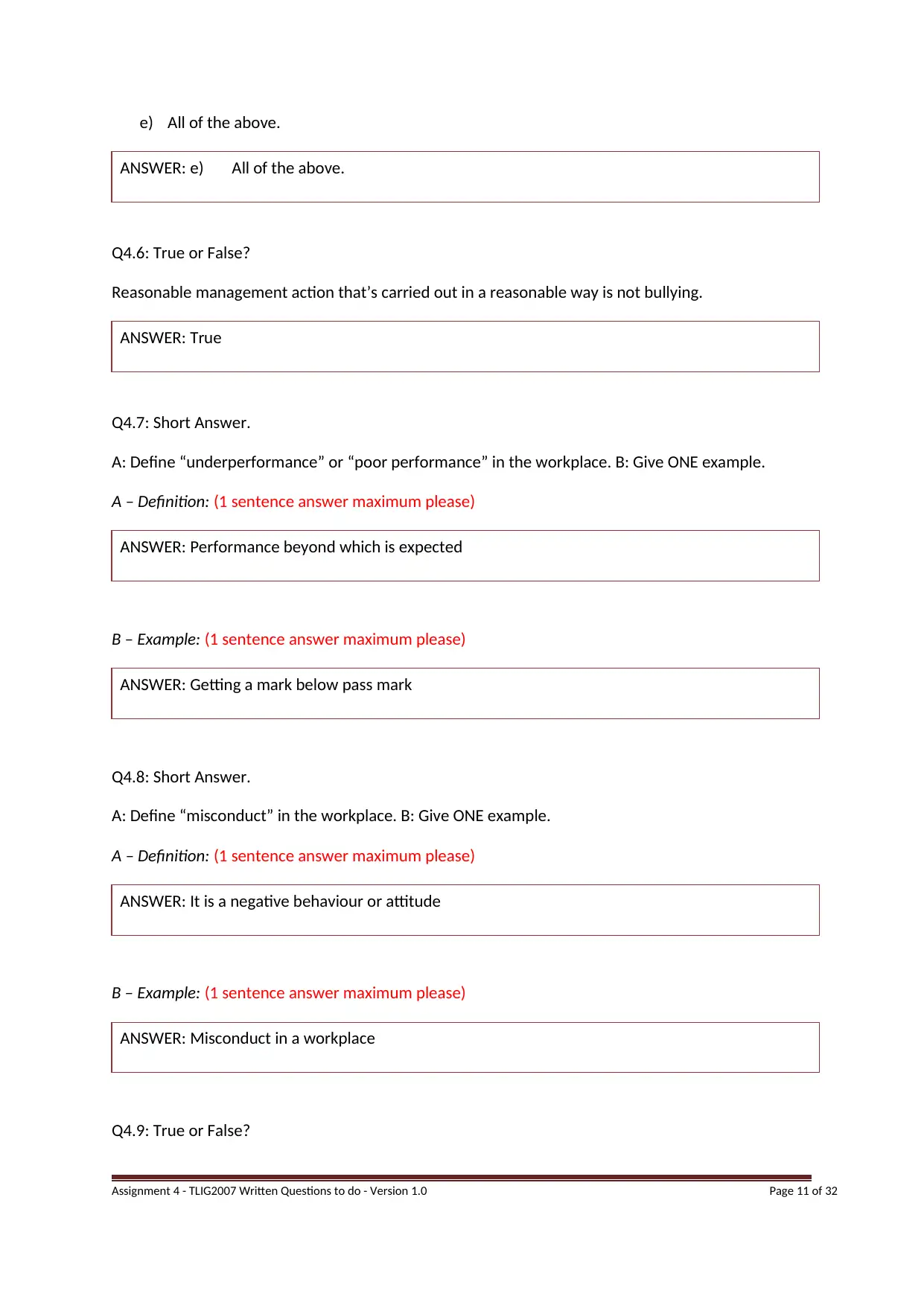
e) All of the above.
ANSWER: e) All of the above.
Q4.6: True or False?
Reasonable management action that’s carried out in a reasonable way is not bullying.
ANSWER: True
Q4.7: Short Answer.
A: Define “underperformance” or “poor performance” in the workplace. B: Give ONE example.
A – Definition: (1 sentence answer maximum please)
ANSWER: Performance beyond which is expected
B – Example: (1 sentence answer maximum please)
ANSWER: Getting a mark below pass mark
Q4.8: Short Answer.
A: Define “misconduct” in the workplace. B: Give ONE example.
A – Definition: (1 sentence answer maximum please)
ANSWER: It is a negative behaviour or attitude
B – Example: (1 sentence answer maximum please)
ANSWER: Misconduct in a workplace
Q4.9: True or False?
Assignment 4 - TLIG2007 Written Questions to do - Version 1.0 Page 11 of 32
ANSWER: e) All of the above.
Q4.6: True or False?
Reasonable management action that’s carried out in a reasonable way is not bullying.
ANSWER: True
Q4.7: Short Answer.
A: Define “underperformance” or “poor performance” in the workplace. B: Give ONE example.
A – Definition: (1 sentence answer maximum please)
ANSWER: Performance beyond which is expected
B – Example: (1 sentence answer maximum please)
ANSWER: Getting a mark below pass mark
Q4.8: Short Answer.
A: Define “misconduct” in the workplace. B: Give ONE example.
A – Definition: (1 sentence answer maximum please)
ANSWER: It is a negative behaviour or attitude
B – Example: (1 sentence answer maximum please)
ANSWER: Misconduct in a workplace
Q4.9: True or False?
Assignment 4 - TLIG2007 Written Questions to do - Version 1.0 Page 11 of 32

A worker is bullied at work if a person or group of people repeatedly act unreasonably towards them
or a group of workers.
ANSWER: True
Assignment 4 - TLIG2007 Written Questions to do - Version 1.0 Page 12 of 32
or a group of workers.
ANSWER: True
Assignment 4 - TLIG2007 Written Questions to do - Version 1.0 Page 12 of 32
⊘ This is a preview!⊘
Do you want full access?
Subscribe today to unlock all pages.

Trusted by 1+ million students worldwide
1 out of 32
Your All-in-One AI-Powered Toolkit for Academic Success.
+13062052269
info@desklib.com
Available 24*7 on WhatsApp / Email
![[object Object]](/_next/static/media/star-bottom.7253800d.svg)
Unlock your academic potential
Copyright © 2020–2025 A2Z Services. All Rights Reserved. Developed and managed by ZUCOL.

